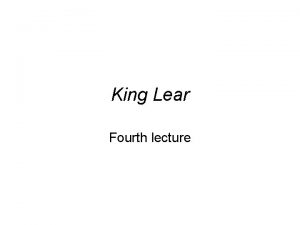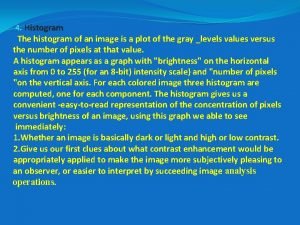DARK ROOM TECHNIQUESPROCESSING DARK ROOM TECHNIQUESPROCESSING DARK ROOM






















- Slides: 22

DARK ROOM TECHNIQUESPROCESSING

�DARK ROOM TECHNIQUESPROCESSING: �DARK ROOM: It should have sufficient space. Near the X-ray examination area. Walls should be constructed of solid concrete -15 cm thick.

�Room should have a lead box inside to store boxes of unexposed films. �Floor should be imprevious to fluids&easy to clean. eglinoleum. �Walls&Roof may be painted white or cream enamal. �Sufficient running water. �Well Ventilation but light proof. Avoid film fog.

�DARK ROOM LAYOUT �DRY SECTION � Dry bench should have enough space open the largest cassette (3’x 2’), height (3’) � It should be provision of cupboardes under the bench top to store cassettes timer and filmarking devices. � Top surface of the bench-good and heavy linoleum � Bracket should be provided over the bench to show different size of film hangers � There should be provision for keeping film storage bins or a lead box to store x-ray film currently in use. � Safe light should be provided to illuminate the area.

Wet section �Used for processing of the film. �China tiles should be fixed on the walls arround processing and washing area. �Safe light in this section too. �A viewer should be provided near the fixed tank. � there should be provision for hanging the towel in this area-hands can be washed and dried and to load the cassette


Safe light �It is a box containing a low watt (10 watt) max, frosted bulb covered by a specific filter. �Safe light must have correct filter � 3’ away from the film �A film should not be left exposed to safe light indefinitely. �Film should be exposed to safe light only during loading and unloading of cassettes and during processing.


Film processing �Film processing consist of film tanks and film solutions. �X-ray films are now universally processed in standard vertical tanks which are available commercially of 9, 13, and 22 liters capacity. �The materials used is either plastic or stainless steel. � 4 tanks are required i. e. for developing, rinsing, fixing and washing. �Tanks may be sterilised using hypochlorite bleaching solution to reduce the risk of bacterial growth.


Processing solutions �Developer reduces exposed silver halide crystals of the film to metallic silver, which converts the latent image into a visible one.

REDUCING AGENT HYDROQUINONE OR METAL IS USED CONVERT EXPOSED SILVER HALIDE CRYSTELL TO METALIC SILVER ACTIVATOR SODIUM CARBONATE IS USED SOFTEN AND SWELL FILM EMULSION RESTRAINER POTASSIUM BROMIDE CONTROL THE ACTIVITY OF REDUSING AGENT PRESERVATIVE SODIUM SULPHITE CONTROL RAPID OXIDATION OF DEVELOPING AGENT SOLVENT WATER SOLVENT FOR CHEMICALS

RINSER �After an exposed film has been developed it is rinsed so to stop overdeveloping and to avoid developer being carried over to c 0 ntaminate fixer. �Running water is used to rinse bath changes about 8 times an hour. �If running water is not available stop bath containing 128 ml of glacial acetic acid in 1 liter water can be used.

FIXING AGENT SODIUM THIOSULPHATE TO REMOVE UNEXPOSED (OR )AMMONIUM SILVER CRYSTALS THIOSULPHATE ACIDIFIER ACETIC ACID (OR) SULPHURIC ACID NEUTRALISE DEVELOPER HARDNER AMMONIUM CHOLRIDE (OR)AMMONIUM SULPHIDE HARDENS SHRINKS AND HARDENS FILM EMULSION PRESERVATIVE SODIUM SULPHITE TO MAINTAIN CHEMICAL BALANCE OF AGENTS USED IN FIXER SOLUTION SOLVENT WATER SOLVENTS FOR CHEMICALS

FUNCTIONS �The clearing time is the time taken by the fixer to convert a cloudy appearance of the film to a clear one. �Removal of unexposed silver crystals. �Shrinks and hardens film emulsion. �Stops development of the film by neutralizing developer.

Film washing �Washing removes excess fixer and residual silver. �It should be done in a large tank with provision of running cold water. �If water in tank is changing 8 to 10 times an hour, 20 min. washing is sufficient. �The fixation time has been prolonged, washing time is increased. �Film can be left overnight in washing but drying time of the film is increased because of swelling of film emulsion. �If washing is not proper film gets discolored with passage of time

Temperature of processing solution �It is important that temperature of developer, fixer, and rinsing and washing tank is maintained at same degree. �LARGE VARIATION IN TEMPERATURE OF VARIOUS SOLUTION CAUSE RETICULATION i. e. CRACKING OF THE FILM EMULSION WHICH PRODUCES A NETWORK OF LINES OVER THE IMAGE.

Film drying �After washing, the film is drained and hung up to dry. �Films should not come in contact with each other and air should be able to freely circulate around them. �It is essential that no dust is present in the room as otherwise films will get spoiled. �Drying cabinets with heating provision can be used to quicken the drying process.

FILM PROCESSING TECHNIQUES �Film can be processed either at a recommended temperature or by using time-temperature combination �Recommended time-temperature combination are: 81/2 min @15. 5’c 6 min @ 18. 5’c 5 min @20’c 41/2 MIN @21’c & 31/2 min @24’c

PROCESSING STEPS �Check the level of processing solution. �Stir the solution. �Check the temperature of solution. �Select correct size film hanger. �Switch on safe light, switch off white light. �Open cassette on dry bench & take out the film. �Fix film in hanger. �Close cassette. �Place film in developer for 4 min.

Cont’ed �Clean hands, reload cassette with a fresh film. �At the end of developing time, lift the film out and allow developer to drain. �Rinse film(10 -20 sec). � transfer the film to fixer for 10 -20 min. �Wash the film in running water for 20 min. �After washing allow the film to dry.

References: �VETERINARY RADIOLOGY BY A. P. SINGH JIT SINGH RADIOGRAPHY IN VETERINARY TECHNOLOGY -LISA M. LAVIN
 Let's look at some examples
Let's look at some examples Dark matter and dark energy ppt
Dark matter and dark energy ppt In a dark dark town
In a dark dark town Darkroom equipment in radiography
Darkroom equipment in radiography Tone and mood in literature
Tone and mood in literature Bungee jumping iceland
Bungee jumping iceland Watch your tone with me boy
Watch your tone with me boy Bedroom kitchen living room
Bedroom kitchen living room Room 19 summary
Room 19 summary Hotel database sql queries
Hotel database sql queries Dark matter pwo
Dark matter pwo All's cheerless dark and deadly
All's cheerless dark and deadly Dark romanticism examples
Dark romanticism examples Why are the middle ages called the dark ages
Why are the middle ages called the dark ages Dark web cp
Dark web cp Hoe kom je op het dark web
Hoe kom je op het dark web In a dark image the components of histogram
In a dark image the components of histogram Linqpad dark theme
Linqpad dark theme My heart was dark with sin song
My heart was dark with sin song Forest personification
Forest personification Light to dark shading
Light to dark shading Dark current measurement
Dark current measurement Dark gold rgb
Dark gold rgb










































